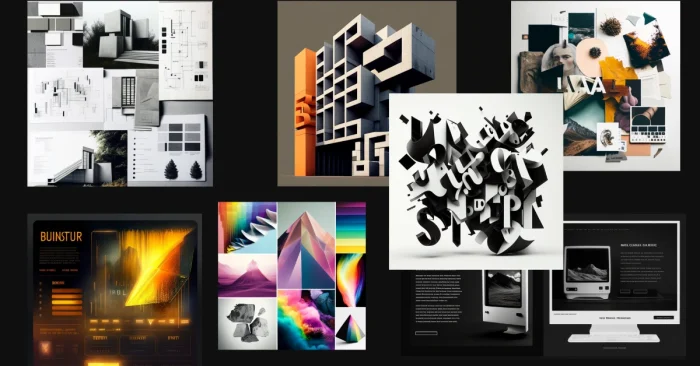Overview
AI tools for mood boards are helping designers, marketers, and creatives quickly translate vague ideas or themes into compelling visual collages. These tools use generative AI, text prompts, image search, layout suggestions, and color palette extraction to build boards that reflect mood, brand aesthetic, or project direction. By automating sourcing of relevant images, styles, and templates, they save time and reduce the effort of manually hunting for visuals. These tools also allow iterative refinement—swapping elements, changing styles, remixing layouts—so mood boards evolve alongside a project’s vision. Whether for brand identity, interior design, campaign planning, or creative inspiration, AI-powered mood boards help convey ideas visually, align teams, and kickstart design workflows more effectively.
1. MyMap.AI – AI Moodboard Maker from Text Prompts
MyMap.AI lets you describe your vision with a prompt (for example, “boho chic living room with earthy tones”) and it automatically generates a professional mood board layout featuring images, textures, color schemes, and design elements pulled from relevant sources. You can then refine: edit layout, swap images, adjust palettes, or add brand-specific fonts. Exporting is easy (PNG/shared link), and collaboration is supported. It’s ideal for designers or clients who need quick visual alignment without deep design skills
2. Venngage – AI Moodboard Generator & Templates
Venngage’s AI moodboard tool provides a fast way to go from concept to aesthetic using templates and AI-assisted image sourcing. You enter a theme (e.g. “minimalist skincare branding”), and it pulls together images, colors, and layout suggestions that match. It also includes brand kit integration so you can use your own fonts, logos, or color codes to make the mood board feel consistent with your identity. Designers use Venngage especially when wanting to align creative direction early with stakeholders.
3. Template.net – Mood Board Generator & Editor
Template.net offers AI-assisted mood board generation plus editor tools so you can customize boards for branding, fashion, interiors, or more. Upload your images or use AI to suggest visuals, adjust layouts, typography, and export in high quality. The platform supports selecting templates designed for different visual styles and allows you to freely modify elements. Useful when you want both speed (from AI suggestions) and control (through manual editing).
4. Miro – AI Moodboard Generator & Collaborative Boards
Miro’s moodboard tool lets teams describe a creative vision in text, then generate matching visuals (images, color themes, visual styles) and iterate in a shared board. You can upload your own assets, use existing board visuals as context, and refine with prompt tweaks. Because Miro is built for collaboration, feedback and alignment happen in real time. Designers appreciate how quickly Miro lets them test different visual directions without needing separate graphic design software.
5. Firefly Boards (Adobe) – Generative Mood Boards & Remixes
Adobe’s Firefly Boards combines templates, stock assets, and generative AI features to create mood boards that can be remixed or re-styled. You can import your own visuals, generate new ones via prompts, change styles, adjust composition, and use features like style references or composition references to guide where images are placed. It supports variation and remixing, so mood boards can evolve as ideas grow. Very useful for creatives who like to explore multiple aesthetics before settling.
6. Mood Board AI – Vision + Categories + Editor
Mood Board AI provides a toolkit where you choose a category (interior design, fashion, wedding, etc.), describe your aesthetic, and receive a tailored mood board. It supports image uploads, AI-chat refinement, and works across design categories. You can also import the board into editors for further customization or integrate suggestion of real-life product images when relevant. For brands or creatives needing themed visuals fast, it’s handy.
7. Bit.ai – Document-Style Mood Boards with Collaboration
Bit.ai offers a mood board generator inside its document/wiki-style workspace. You can gather images, videos, fonts, colors, links in a scrollable format, collaborate with team members, and create branded boards. It’s especially useful when mood boards form part of a larger brief or content strategy document. Because everything lives in one place, feedback and iteration are smoother
8. Dresma – Data-Backed Mood Board Generator
Dresma goes beyond just aesthetics: it analyzes top-performing visuals in your niche (Instagram, Pinterest, etc.), checks competitor style, brand voice, audience preferences, and recommends a mood board tailored for your category. This “data meets design” approach helps ensure your mood board doesn’t just look good, but aligns with what works in your market. Great for e-commerce or social campaigns.
9. MoodBoardly / Mood Board Editor – Customization & Product Integration
MoodBoardly (also known as Mood Board Editor) gives you a flexible editor: import favorites, remove backgrounds, crop/flip images, sync product visuals, and art direction adjustments. It’s a mix between inspiration gathering and nearly polished visual layout. Useful for creatives who want to mix mood with practical assets.
10. Lunacy (Icons8) – Free Mood Board Maker with Built-In Assets
Lunacy provides a free mood board creator where you can use built-in libraries of photos, illustrations, icons, plus upload your own visuals. The editor functions like drag-and-drop: arrange images, adjust size, position, add text, colors. It’s simple but powerful for early phase design sketches or inspiration boards, especially when working fast or on low budget.
(FAQs)
Q1: Can AI mood board tools maintain brand style consistency?
Yes, many tools allow you to upload brand logos, set brand color palettes, fonts, and reference imagery. Then you give prompts that align with your brand aesthetic. Iteration and prompt refinement help maintain consistency.
Q2: Do I need design skills to use these tools?
No. Most of these tools are built for non-designers too: simple drag & drop, pre-made templates, AI-suggested layouts, automatic image and color matching mean you can get good results without expert skills.
Yes. Tools like MyMap.AI, Miro, Firefly Boards, Venngage, etc. allow export (PNG, PDF) and sharing via link or collaboration features. That makes presenting or getting feedback easier.
Learn More About AI Course https://buhave.com/courses/learn/ai/
















